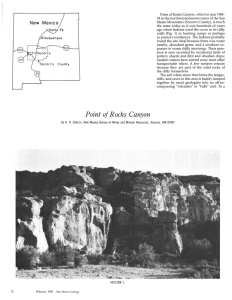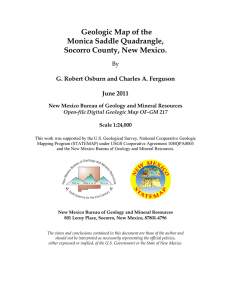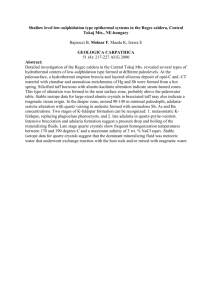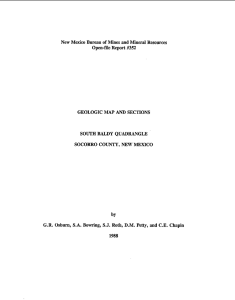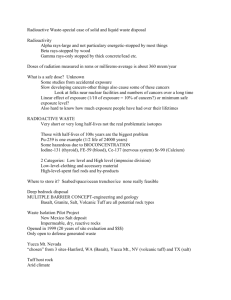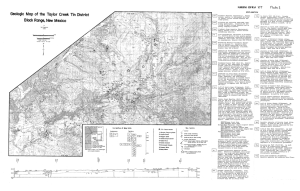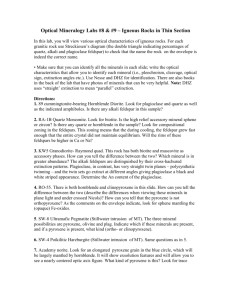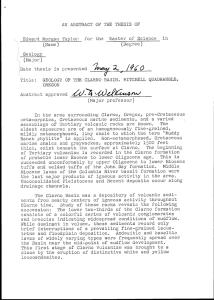I
advertisement
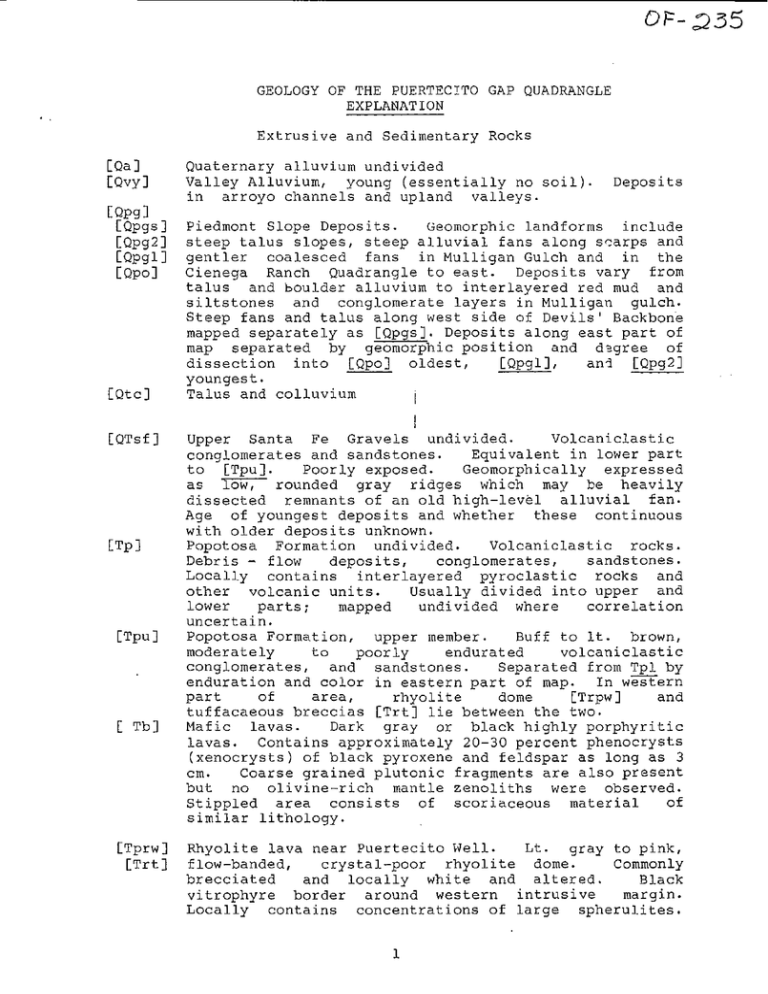
GEOLOGY OF THE PUERTECITO GAP QUADRANGLE EXPLANATION Extrusive and Sedimentary Rocks CQa I [Qvyl CQpg 1 CQpgs] [Qpg2] [Qpgl] [Qpo] [Qtcl Quaternary alluvium undivided Valley Alluvium,young (essentially no soil). in arroyo channels and upland valleys. Deposits Piedmont Slope Deposits. Geomorphic landforms include steep talus slopes, steep alluvialfans along scarps and gentler coalesced fans in Mulligan Gulch andin the Cienega Ranch Quadrangle to east. Deposits vary from talus and boulder alluvium to interlayered red mud and siltstones and conglomerate layers in Mulligan gulch. Steep fans and talus along west side of Devils' Backbone mapped separately as [Qpys]. Deposits along east part of map separated by geomorphic position and d-gree of dissection into [Qpo] oldest, [Qpgl], an3 CQpg21 youngest. I Talus and colluvium I [QTsf] CTp 1 [Tpu] ~ [ Tb] [Tprw] [Trt] Upper Santa Fe Gravels undivided. Volcaniclastic conglomerates and sandstones. Equivalent in lower part to [Tpu]. Poorly exposed. Geomorphically expressed as low,rounded gray ridges which may be heavily dissected remnants of an old high-level alluvial fan. Age of youngest deposits and whether these continuous with older depositsunknown. Popotosa Formation undivided. Volcaniclastic rocks. Debris flow deposits, conglomerates, sandstones. Locally contains interlayered pyroclastic rocks and other volcanic units. Usually divided into upper and lower parts; mapped undivided where correlation uncertain. to It. brown, PopotosaFormation, uppermember.Buff moderately to pooriy endurat ed volcaniclastic conglomerates, and sandstones. Separated from Tpl by enduration and color in eastern part of map. In western and part of area, rhyolite dome CTrpw 1 tuffacaeous breccias [Trt] lie between the two. Mafic lavas.Darkgrayorblack highly porphyritic lavas. Contains approximately 20-30 percent phenocrysts (xenocrysts) of black pyroxene and feldspar as long as 3 cm. Coarse grained plutonic fragments are alsopresent but no olivine-rich mantle zenoliths were observed. of Stippled area consists of scoriaceous material similar lithology. - Rhyolite lava near Puertecito Well. Lt. gray to pink, Commonly flow-banded, crystal-poor rhyolite dome. Black brecciated and locally white and altered. margin. vitrophyre border around western intrusive Locally contains concentrations of largespherulites. 1 Contains 2-4 percent phenocrysts consisting of subequal amounts of quartz and feldspar. In addition, small tabular holes suggest a second variety of feldspar (probably plagioclase) was removed by alteration. Appears to have associated breccia and pyroclastic apron [Trt] w h i c h is interlayeredinPopotosa sedimentary rocks. PopotosaFormation, tuffaceous interval. Interlayered red highly endurated volcaniclastic sedimentary and Sedimentary rocks are a p y r o c l a s t i cr o c k s . continuation of [Tpl] sedimentation. Pyroclastic rocks consist of several thin pyroclastic flows separated by bedded tuffaceous layers, probably air-fall and surge deposits and sedimentary interlayers. The ash-flow tuffs contain a few percent quarts and Kspar(?) phenocrystsinroughlyequalproportions.Coarse debris-flow usually makes up top layer of unit. Popotosa Formation, lower member. Dark-red, highly endurated volcaniclastic sedimentary rocks. Contain debris-flow deposits, conglomerates, and sandstones with minor amounts of finer grained layers. Tuff of Chocle $ell? [Ferguson, 19851 0-300 ft (0-90m); ash-flowtuffs.Pinkishgray,denselywelded, moderately crystal-poor ash-flow tuff. Contairs 5 to 10 of subequal amounts of percent phenocrysts consisting Kspar and quarts. Correlation based only on position above [Tsc] and general lithologic similarity. Tuff somewhat brecciated and silicified. Mapped only on main ridge north of Puertecito Gap. La Jara Peak Basaltic Andesite [Tonking, 19573--400 ft (130m); basalt to basaltic andesite lavas. 0-cur only in extreme northwestern part of bedrock outcrop. Several mafic lava flows separated by flow breccia. Contain a few percent altered ferromag pheqocrysts. Some flows also contain a few percent plagioclase phenocrysts. South Canyon Tuff [Osburn, 19781--0-400 ft (0-130m); ash-f low tuffs. Lt. gray to brownish-gray in color. Crystal-poor lower interval (2-4%) grades SharFly upward near middle of unit to moderately crystal-rich upper interval which contains 20-25 percent phenocrq-st. Both intervals contain subequal quartz and sanidine, minor of sphene. plagioclase and biotite, and trace amounts Locally, as in northwesternmost exposure, unit contains of feet thick, with an upper interval, a few tens markedly less quartz and more biotite. This interval was not observed in any of the eastern exposures making correlation between these two areas somewhat uncertain. Eastern exposures commonly exhibit a marked welding break about the middle of the unit somewhat below the increase in phenocryst content. Lemitar Tuff [Osburn, 1978; Chamberlin, 1980]--150-1000 ft (50-300m); ash-flow tuff. Simple coolin3 unit of densely welded tuff showing strong compositional Zoning2 Divided into lower, It-grayto pale-red, crystal-poor (10-15%), rhyolitic member [Tll] and an upper medium-red to light yellowish-gray, crystal-rich member. The upper member is zoned from a lower, plagioclase-rich, quartzpoor, quartz latite at the base to a quartz-rich rhyolite at thetop. Unit very thick toward the north part of the map area and thins dramatically toward south. the [TxI SawmillCanyonFormation.Calderafill of Sawmill Canyon-Magdalena cauldron (Osburn and Chapin, 1983). Divided into several members within this map area. [Txc] Tuff of Caronita Canyon [Petty, 1979]--0-1200 ft ( 0 [Txcu] 3 5 0 m ) ; ash-flow tuffs. Multiple flow, complex cooling [Txcl] unit showinq stronq compositional and textural variations. \There thicker, divided into phenocryst-poor brown to reddish, lower member [Txcl] and phenocrystrich white to medium-gray upper member [Txcu]. Lower member contains 10-20 percent phenocrysts of plagioclase, biotite, magnetite and traces of clinopyro xene, quartz and sanidine, and often has black basal vitrophyre. The lower member is welded to and gradational with (usually over a few feet) an upper phenocryst-rich member which contains 30-50 percent phenocrysts of sanidine, quartz, biotite znd minor magnetite. Quartz is often conspicuously large and dipyramidal. Locally, in this area, both members contain numerous interlayers of bedded tuffaceous material. In some exposures this interlayering is so pronounced that a the unit has a bedded appearance when viewed from distance. Mafic lavas--0-300 ft (0-loom). Dense, aphanitic to slightly porphyritic, brownish-gray mafic lavas. Some flows contain a few percent plagioclase an3 altered ferromagnesiQn phenocrysts and most are highly vesicular. Rocks are probably basaltic andesite or basalt chemically. Volcanisclastic sedimentary rocks. Expose3 only in northeastern part of map area. Dominantly consist Of coarse debris-flow deposits with minor interlayers of sandstone. Overlies and is gradational with brecciasOf rhyolite dome [Txrl]. Rhyolite dome complex. Pale-red, aphanitic to slightly prophyritic, sometimes sugary in texture flow-banded rhyolite lavas. Contain sparce quartz phenocrysts i f porphyritic. Typically contain abundant sp’Ierulitic textures and stand as resistant cliffs and ridges. Vicks Peak Tuff [Deal and Rhodes, 1976]--0-€00 ft ( 0 250m): ash-flow tuffs moderately to densely welded, crystal-poor, ash-flow tuff. Lower very crystal poor commonly lithophysal interval grades upward in top half of unit to less crystal poor interval contairing large 3 pumice. Pumice, in this interval, may be gray with a white r i m and largely filled with vapor phase minerals or dark chocolate brown and fine grained. Top few feet of unit usually pale redwith dark pumice; perhaps a high temperature oxidation effect. Second cooling unit a few 10's of feet thick common above main unit along west face of Devils Backbone. This interval very fine grained and crystal-poor similar to lowest par? of unit. Lower parts of major unit contain pronounced lineation in south half of area. Entire unit punky, poorly welded and thin to absent in north part of area. [Tj 1 La Jencia Tuff [Osburn and Chapin, 1983]--0-900 ft(0275m); ash-flow tuffs. Thick sequence of densely welded, crystal-poor, ash flow tuff. Commonly reddish to reddish brown in lower part withgray highly vapor phase altered upper part which resembles Vicks Peak Tuff. Top 30-40 ft of unit pale-red with dark pumice similar to top of Vicks Peak. Contains 5-10% total phenocrysts consisting mainly of Kspar with minor (1-2%) quartz, an3 biotite and a ,trace of clinopyroxene. Within this area usually crops out as two resistant intervals separated by a bench./ The lower cliff forming interval is usually reddish with large light-colored pumice and the upper is gray and altered by vapor phase recrystallization. Pumice in the upper interval are often filled with coarse vapor phase minerals and pumice bound?ries are often indistinct. Strongly lineated in north partof map area but lineation obscure and indistinct in southwest. [Tz 1 Luis Lopez Formation. Heterolithic fill of Socorro [Tzrl] cauldron. Consists mostly of intermediate to mafic lavas [Tza] in this map area. These lavas are highly CTzal CTza21 variable.in texture. Most are aphanitic to slightly [Tzal] plagioclase and pyroxene porphyritic [Tzal Roth's area]. One distinctive highlyporphyritis lava containing 15-20 1 cm in length was percent plagioclase phenocrysts to separated by Roth as [Tsa2]. In other areas the lavas were mapped undivided. A highly porphyritic variety with feldspar phenocrysts to 3 cm is common in all outcrop areas but was not separated due to poor exposures. of part Mafic lavas overlain, in the extreme northeast map area, by gray and moderate-red flow-banded, phenocryst-poor rhyolitic lavas. Rhyolite contains trace amounts of biotite and plagioclase phenocrysts and commonly has abundant spherulites. These lavas are thicker and more widespread toward the east. [Thm] [Thmm] Hells Mesa Tuff [Deal, 1973; Simon, 1973]-->650 ft (200m); ash-flow tuffs. Thick, massive crystal-rich 2 0 - 5 0 % , quartz-rich ash-flow tuff. Commonly lithic-rich with lithic's weathering out to a vuggy appearing outcrop. Pumice locally, especially in easterl outcrop, also weather out preferentially. Lithic fragments 4 include mafic to intermediate lavas, p€ granites and schists, and an abundance of rhyolitic fragments, some large enough to showof map scale [Thmm]. T’le top of the unit locally contains much fewer phenocr:ysts than normal ( “ 2 0 % ) and weathers recessively. In total, the unit here is lithic-rich and variable and much more similar to the intra-cauldron Hells Mesa than to the consistently lithic-poor monotonously uniform outflow of the Hells Mesa. CTdl Datil Group [Osburn and Chapin, cross section. 19833. Show7 only on Intrusive Rocks [Trial ! I Rhyolite near Antelope Well [New Name] -- intrusive: rhyolitic lavas. Lt. tanphenocryst-poorrhyolite intrusion. Stratigraphic position uncertainbct clearly older than La Jencia Tuff which overlies rhyolite on surface of considerable relief. [Tri] Rhyolite intrusion. Lt. gray to brown, phenocryst-free to phenocryst-poor. Cross-cuts units as young as upper Caronita Canyon Tuff: minimum age unconstrained. Found only in north central part of map. [Tr3] Rhyolite intrusions. Flow-banded phenocryst-poor [Tr4] rhyoliticlavas.Containtrace to 2 % quartz [Trx] phenocrysts. Tr4 intrudes Tr3 but otherwise very similar lithologically. Contain large blocks xenolith? of other rock types mainly phenocryst-poor ash-flow tuffs. [Trx] Symbols ”” Geologic contact _ _ _ . A ’ Contact inferred from aerial photography / .... /’ 2 . ‘ 9 . Fault, bar and ball on downthrown side, dashed where approximately lo-ated or uncertain, dotted under coveringunit. Dip direction and angle noted where obscured Strike and dip of bedding and compaction 11 Y -2 4”+ foliation in ash-flow tuffs Foli-ation in rhyolite lavas Enlongation directionof lincated ash-f low tuffs 5 pumice in / Ab A 1 Transport direction in sedimentary rocks Brecciated area I ." . . . . ........ . . ~. .. 2 .~ ...... . ~ . ..... ! . . : ::. . .. ......... . .. . .- ....... .. I . . . . . ".. .... ... .. .... . " . L . " " -.::."-".-I . . " .. .. -..... . . . . . .... . . . .. .. ... . . . . . . . . . .. .. . 7 _:.,.:.... ... .* . . . . . . . . . .... .... "_ . . .. .. . . . . __ ...... ....... .... ". .......... " . . ... " ... . . . .. " " . . . . . . . . . . . . . . . . ,,.. ..~ , ..... . . ,.. .- 1 . ' .. I I . ..... '_.,_.. . . . . . . . . . . . ..... ' .. . . . . . . . .. . . , . . . . . . . ..,. . .. .. .. . ._.. ...:.. ;:, ._..: ...... Vh
